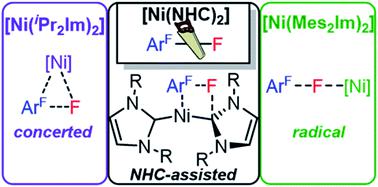当前位置:
X-MOL 学术
›
Chem. Sci.
›
论文详情
Our official English website, www.x-mol.net, welcomes your
feedback! (Note: you will need to create a separate account there.)
Coligand role in the NHC nickel catalyzed C–F bond activation: investigations on the insertion of bis(NHC) nickel into the C–F bond of hexafluorobenzene
Chemical Science ( IF 7.6 ) Pub Date : 2020-10-06 , DOI: 10.1039/d0sc04237d Maximilian W. Kuntze-Fechner 1, 2, 3, 4 , Hendrik Verplancke 4, 5, 6, 7 , Lukas Tendera 1, 2, 3, 4 , Martin Diefenbach 4, 5, 6, 7 , Ivo Krummenacher 1, 2, 3, 4, 8 , Holger Braunschweig 1, 2, 3, 4, 8 , Todd B. Marder 1, 2, 3, 4, 8 , Max C. Holthausen 4, 5, 6, 7 , Udo Radius 1, 2, 3, 4
Chemical Science ( IF 7.6 ) Pub Date : 2020-10-06 , DOI: 10.1039/d0sc04237d Maximilian W. Kuntze-Fechner 1, 2, 3, 4 , Hendrik Verplancke 4, 5, 6, 7 , Lukas Tendera 1, 2, 3, 4 , Martin Diefenbach 4, 5, 6, 7 , Ivo Krummenacher 1, 2, 3, 4, 8 , Holger Braunschweig 1, 2, 3, 4, 8 , Todd B. Marder 1, 2, 3, 4, 8 , Max C. Holthausen 4, 5, 6, 7 , Udo Radius 1, 2, 3, 4
Affiliation

|
The reaction of [Ni(Mes2Im)2] (1) (Mes2Im = 1,3-dimesityl-imidazolin-2-ylidene) with polyfluorinated arenes as well as mechanistic investigations concerning the insertion of 1 and [Ni(iPr2Im)2] (1ipr) (iPr2Im = 1,3-diisopropyl-imidazolin-2-ylidene) into the C–F bond of C6F6 is reported. The reaction of 1 with different fluoroaromatics leads to formation of the nickel fluoroaryl fluoride complexes trans-[Ni(Mes2Im)2(F)(ArF)] (ArF = 4-CF3-C6F4 2, C6F5 3, 2,3,5,6-C6F4N 4, 2,3,5,6-C6F4H 5, 2,3,5-C6F3H2 6, 3,5-C6F2H3 7) in fair to good yields with the exception of the formation of the pentafluorophenyl complex 3 (less than 20%). Radical species and other diamagnetic side products were detected for the reaction of 1 with C6F6, in line with a radical pathway for the C–F bond activation step using 1. The difluoride complex trans-[Ni(Mes2Im)2(F)2] (9), the bis(aryl) complex trans-[Ni(Mes2Im)2(C6F5)2] (15), the structurally characterized nickel(I) complex trans-[NiI(Mes2Im)2(C6F5)] (11) and the metal radical trans-[NiI(Mes2Im)2(F)] (12) were identified. Complex 11, and related [NiI(Mes2Im)2(2,3,5,6-C6F4H)] (13) and [NiI(Mes2Im)2(2,3,5-C6F3H2)] (14), were synthesized independently by reaction of trans-[Ni(Mes2Im)2(F)(ArF)] with PhSiH3. Simple electron transfer from 1 to C6F6 was excluded, as the redox potentials of the reaction partners do not match and [Ni(Mes2Im)2]+, which was prepared independently, was not detected. DFT calculations were performed on the insertion of [Ni(iPr2Im)2] (1ipr) and [Ni(Mes2Im)2] (1) into the C–F bond of C6F6. For 1ipr, concerted and NHC-assisted pathways were identified as having the lowest kinetic barriers, whereas for 1, a radical mechanism with fluoride abstraction and an NHC-assisted pathway are both associated with almost the same kinetic barrier.
中文翻译:

配体在NHC镍催化的CF键活化中的作用:关于将双(NHC)镍插入六氟苯的CF键中的研究
[Ni(Mes 2 Im)2 ](1)(Mes 2 Im = 1,3-dimesityl-咪唑啉-2-亚基)与多氟芳烃的反应以及有关1和[Ni(i Pr 2 Im)2 ](1 ipr)(i Pr 2 Im = 1,3-二异丙基-咪唑啉-2-亚基)被报道为C 6 F 6的CF键。1与不同氟代芳烃的反应导致反式-[Ni(Mes 2 Im)2(F)(AR ˚F)](氩˚F = 4-CF 3 -C 6 ˚F 4 2,C 6 ˚F 5 3,2,3,5,6--C 6 ˚F 4 Ñ 4,2,3,5 ,6-C 6 ˚F 4 ħ 5,2,3,5-C 6 ˚F 3 ħ 2 6,3,5--C 6 ˚F 2 ħ 3 7)在公平的良好的产率与五氟苯基的形成的例外复合3(小于20%)。检测到1与C 6 F 6反应的自由基物质和其他反磁性副产物,与使用1进行C–F键活化步骤的自由基途径一致。二氟化物配合物反式-[Ni(Mes 2 Im)2(F)2 ](9),双(芳基)配合物反式-[Ni(Mes 2 Im)2(C 6 F 5)2 ](15),结构表征的镍(I)配合物反式-[Ni I(MES 2林)2(C 6 ˚F 5)](11)和金属基团的反式- [镍我(MES 2林)2(F)](12)进行了鉴定。络合物11及其相关的[Ni I(Mes 2 Im)2(2,3,5,6-C 6 F 4 H)](13)和[Ni I(Mes 2 Im)2(2,3,5- C 6 F 3 H 2)](14),是通过反式-[Ni(Mes 2 Im)2(F)(Ar F)]与PhSiH 3反应独立合成的。排除了从1到C 6 F 6的简单电子转移,因为反应伙伴的氧化还原电位不匹配,并且未检测到独立制备的[Ni(Mes 2 Im)2 ] +。DFT计算是在插入[Ni(i Pr 2 Im)2 ](1 ipr)和[Ni(Mes 2 Im)2 ](1)插入C 6 F 6的CF键中。对于1个IPR,一致和NHC辅助通路被确定为具有最低动力学障碍,而对于1,用氟抽象和NHC辅助通路自由基机理都与几乎相同的动力学屏障相关联。
更新日期:2020-10-14
中文翻译:

配体在NHC镍催化的CF键活化中的作用:关于将双(NHC)镍插入六氟苯的CF键中的研究
[Ni(Mes 2 Im)2 ](1)(Mes 2 Im = 1,3-dimesityl-咪唑啉-2-亚基)与多氟芳烃的反应以及有关1和[Ni(i Pr 2 Im)2 ](1 ipr)(i Pr 2 Im = 1,3-二异丙基-咪唑啉-2-亚基)被报道为C 6 F 6的CF键。1与不同氟代芳烃的反应导致反式-[Ni(Mes 2 Im)2(F)(AR ˚F)](氩˚F = 4-CF 3 -C 6 ˚F 4 2,C 6 ˚F 5 3,2,3,5,6--C 6 ˚F 4 Ñ 4,2,3,5 ,6-C 6 ˚F 4 ħ 5,2,3,5-C 6 ˚F 3 ħ 2 6,3,5--C 6 ˚F 2 ħ 3 7)在公平的良好的产率与五氟苯基的形成的例外复合3(小于20%)。检测到1与C 6 F 6反应的自由基物质和其他反磁性副产物,与使用1进行C–F键活化步骤的自由基途径一致。二氟化物配合物反式-[Ni(Mes 2 Im)2(F)2 ](9),双(芳基)配合物反式-[Ni(Mes 2 Im)2(C 6 F 5)2 ](15),结构表征的镍(I)配合物反式-[Ni I(MES 2林)2(C 6 ˚F 5)](11)和金属基团的反式- [镍我(MES 2林)2(F)](12)进行了鉴定。络合物11及其相关的[Ni I(Mes 2 Im)2(2,3,5,6-C 6 F 4 H)](13)和[Ni I(Mes 2 Im)2(2,3,5- C 6 F 3 H 2)](14),是通过反式-[Ni(Mes 2 Im)2(F)(Ar F)]与PhSiH 3反应独立合成的。排除了从1到C 6 F 6的简单电子转移,因为反应伙伴的氧化还原电位不匹配,并且未检测到独立制备的[Ni(Mes 2 Im)2 ] +。DFT计算是在插入[Ni(i Pr 2 Im)2 ](1 ipr)和[Ni(Mes 2 Im)2 ](1)插入C 6 F 6的CF键中。对于1个IPR,一致和NHC辅助通路被确定为具有最低动力学障碍,而对于1,用氟抽象和NHC辅助通路自由基机理都与几乎相同的动力学屏障相关联。











































 京公网安备 11010802027423号
京公网安备 11010802027423号